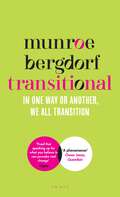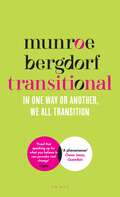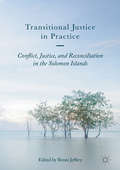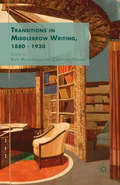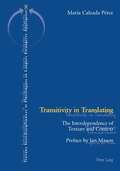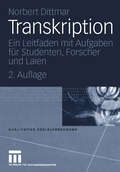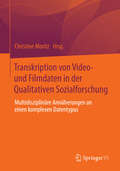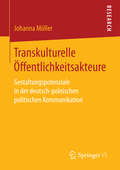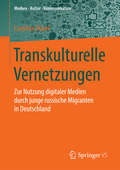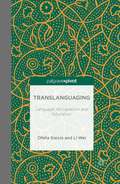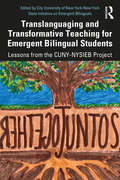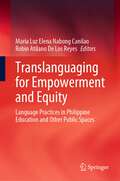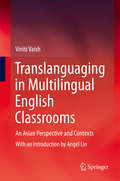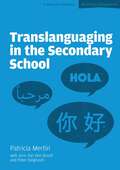- Table View
- List View
Transitional: In One Way or Another, We All Transition
by Munroe Bergdorf** PRE-ORDER NOW **'Bergdorf is proof that speaking up for what you believe in can provoke real change' Vogue'A phenomenon' Owen Jones, Guardian'A powerful and unstoppable new force . . . The world should take notice' Teen Vogue'One of the UK's most committed and outspoken transgender activists' StylistTransitioning is an alignment of the invisible and the physical. It is truth rising to the surface. It is one of the most fundamental aspects of the human condition – a part of our experience as a conscious being, no matter who we are.As time goes on, we all develop as people. We all transition. It's what unites us, not what separates us.In this life-affirming, heartfelt and intimate book, activist and model Munroe Bergdorf shares reflections from her own life to illustrate how transitioning is an essential part of all our lives. Through the story of one woman's extraordinary mission to live with authenticity, Transitional shows us how to heal, how to build a stronger community and how to evolve as a society out of shame and into pride.
Transitional: In One Way or Another, We All Transition
by Munroe Bergdorf** PRE-ORDER NOW **'Bergdorf is proof that speaking up for what you believe in can provoke real change' Vogue'A phenomenon' Owen Jones, Guardian'A powerful and unstoppable new force . . . The world should take notice' Teen Vogue'One of the UK's most committed and outspoken transgender activists' StylistTransitioning is an alignment of the invisible and the physical. It is truth rising to the surface. It is one of the most fundamental aspects of the human condition – a part of our experience as a conscious being, no matter who we are.As time goes on, we all develop as people. We all transition. It's what unites us, not what separates us.In this life-affirming, heartfelt and intimate book, activist and model Munroe Bergdorf shares reflections from her own life to illustrate how transitioning is an essential part of all our lives. Through the story of one woman's extraordinary mission to live with authenticity, Transitional shows us how to heal, how to build a stronger community and how to evolve as a society out of shame and into pride.
Transitional Justice in Practice: Conflict, Justice, and Reconciliation in the Solomon Islands
by Renée JefferyThis book examines the practice of transitional justice in the Solomon Islands from the period of the ‘The Tensions’ to the present. In late 1998, the Solomon Islands were plunged into a period of violent civil conflict precipitated by a complex web of grievances, injustices, ethnic tensions, and economic insecurities. This conflict dragged on until the middle of 2003, leaving an estimated 200 people dead and more than 20 000 displaced from their homes. In the time that has elapsed since the end of The Tensions, numerous—at times incompatible—approaches to transitional justice have been implemented in the Solomon Islands. The contributors to this volume examine how key global trends and debates about transitional justice were played out in the Solomon Islands, how its key mechanisms were adapted to meet the specific demands of post-conflict justice in this local context, and how well its practices and processes fulfilled their perceived functions.
Transitions in Middlebrow Writing, 1880 - 1930
by Kate Macdonald Christoph SingerThis book examines the connections evident between the simultaneous emergence of British modernism and middlebrow literary culture from 1880 to the 1930s. The essays illustrate the mutual influences of modernist and middlebrow authors, critics, publishers and magazines.
Transitive Nouns and Adjectives: Evidence from Early Indo-Aryan (Oxford Studies in Diachronic and Historical Linguistics #25)
by John J. LoweThis book explores the wealth of evidence from early Indo-Aryan for the existence of transitive nouns and adjectives, a rare linguistic phenomenon which, according to some categorizations of word classes, should not occur. John Lowe shows that most transitive nouns and adjectives attested in early Indo-Aryan cannot be analysed as a type of non-finite verb category, but must be acknowledged as a distinct constructional type. The volume provides a detailed introduction to transitivity (verbal and adpositional), the categories of agent and action noun, and to early Indo-Aryan. Four periods of early Indo-Aryan are selected for study: Rigvedic Sanskrit, the earliest Indo-Aryan; Vedic Prose, a slightly later form of Sanskrit; Epic Sanskrit, a form of Sanskrit close to the standardized 'Classical' Sanskrit; and Pali, the early Middle Indo-Aryan language of the Buddhist scriptures. John Lowe shows that while each linguistic stage is different, there are shared features of transitive nouns and adjectives which apply throughout the history of early Indo-Aryan. The data is set in the wider historical context, from Proto-Indo-European to Modern Indo-Aryan, and a formal linguistic analysis of transitive nouns and adjectives is provided in the framework of Lexical-Functional Grammar.
Transitivity In Translating: The Interdependence Of Texture And Context (pdf)
by Maria Calzada PérezThis book proposes an overall framework of communication (including translation) that follows CDA (Critical Discourse Analysis)/CL (Critical Linguistics) principles; it devises an analytic tool for the study of transitivity in translation along Hallidayian-functionalist lines; and it incorporates a contrastive corpus of 52 speeches made before the European Parliament in English and Spanish on 9th March 1993 together with their corresponding translations. Both sentence and textual levels become units of analysis. Also, quantitative and qualitative methods are applied. The author analyses the various types of transitivity shifts at sentence level. She also shows that these shifts have contextual effects. Another focus of this study is to present how certain transitivity shifts group together.
Transitivity, Valency, and Voice (Oxford Studies in Typology and Linguistic Theory)
by Denis CreisselsThis book sets up a consistent theoretical and terminological framework for the study of the phenomena that are commonly subsumed under the terms transitivity, valency, and voice. These three concepts are at the heart of the most basic aspects of clausal structure in any language; however, there is considerable cross-linguistic variation in the constraints on how verbs combine with noun phrases that refer to participants in the event that they denote or to the circumstances of the event. In this book, Denis Creissels explores and accounts for the extent of this cross-linguistic variation, capturing its regularities and examining the historical phenomena that have resulted in the emergence of constructions and markers. The novel framework developed in the book allows similar phenomena to be identified across typologically diverse languages, and facilitates systematic comparison of the manifestations of these phenomena in the grammars of individual languages.
Transkription: Ein Leitfaden mit Aufgaben für Studenten, Forscher und Laien (Qualitative Sozialforschung #10)
by Norbert DittmarDas Buch liefert eine Darstellung von gängigen Transkriptionsverfahren in wissenschaftlichen und institutionellen Bereichen nach Kriterien der jeweiligen Gebrauchsfunktionen und Anleitung zur Anfertigung von Transkriptionen nach den Vorgaben eines bestimmten Systems.
Transkription von Video- und Filmdaten in der Qualitativen Sozialforschung: Multidisziplinäre Annäherungen an einen komplexen Datentypus
by Christine MoritzWährend die Transkription einer Audioaufzeichnung (z.B. von Interviews) als Usus bezeichnet wird und auf ein Set an etablierten Verfahren zurückgreifen kann, wird über unterschiedliche Formen der Transkription von Video- und Filmdaten in den einzelnen Disziplinen der Qualitativen Sozialforschung anhaltend diskutiert. Die Notwendigkeit einer Erfassung der Bedeutungsträger in ihrer Linearität und Gleichzeitigkeit wird in den meisten Fällen durch die Kombination aus interpretativen und deskriptiven Verfahren mithilfe diagrammatischer Schreibweisen („Partituren“) gelöst. Quer zur disziplinären Forschungspraxis finden sich Gemeinsamkeiten bei der Videotranskription in multidisziplinärer Weise, weshalb der Sammelband die derzeit bestehenden Transkriptions-Praktiken des Videos oder des Films aus verschiedenen Fächern des deutschsprachigen und internationalen Raumes bündelt.
Transkulturalität der Deutschschweizer Literatur: Entgrenzung durch Kulturtransfer und Migration
by Vesna Kondrič HorvatDer Band enthält 21 Studien zur Deutschschweizer Literatur und veranschaulicht, dass sie schon längst transkulturell geworden ist. Die Beiträge zeigen, dass sie Elemente vieler Kulturen in sich trägt, die ineinander übergehen und sich verflechten. Zahlreiche Autoren und Autorinnen mit Migrationshintergrund in der Schweiz, aber auch andere Schweizer Autoren und Autorinnen haben sich aus den engen nationalen Rahmen befreit, und der Blick in ihren Werken schweift immer weiter. Das Buch eröffnet neue Perspektiven, die sich ergeben, wenn in der Literatur das Eigene und das Fremde nicht mehr getrennt werden, wenn man den Kulturtransfer, die Entgrenzung, transkulturelle Vernetzung und vieles mehr beobachtet.
Transkulturelle Öffentlichkeitsakteure: Gestaltungspotenziale in der deutsch-polnischen politischen Kommunikation
by Johanna MöllerJohanna Möller untersucht das kommunikative Handeln grenzüberschreitend medial agierender deutscher und polnischer Eliteakteure. Gefragt wird nach Gestaltungspotenzialen in der öffentlichen politischen Kommunikation. Vorrangig auf Basis qualitativer Interviews rekonstruiert die Autorin aus der Perspektive dieser transkulturellen Öffentlichkeitsakteure Möglichkeiten, sich grenzüberschreitend medial zu beteiligen und die verschiedenen Öffentlichkeiten zu prägen. So werden zum einen kommunikative Kompetenzen als Handwerkszeug öffentlich-kommunikativen Handelns und zum anderen Akteursmodi als Formen und Möglichkeiten öffentlichen Auftretens ermittelt. Solche Gestaltungspotenziale werden schließlich über eine qualitative Medieninhaltsanalyse in charakteristische Diskurskontexte der deutsch-polnischen politischen Kommunikation eingeordnet.
Transkulturelle Vernetzungen: Zur Nutzung digitaler Medien durch junge russische Migranten in Deutschland (Medien • Kultur • Kommunikation)
by Caroline DüvelIn einer empirischen Untersuchung zeigt Caroline Düvel, welche Bedeutung junge russische Migranten dem Mobiltelefon und dem Internet zuschreiben und in welcher Beziehung die Mediennutzung zu ihrer kulturellen Verortung steht. Herausgearbeitet wird der Zusammenhang zwischen der Medienaneignung und der Artikulation kultureller Identität durch die jungen Russen sowie zwischen ihrer Integration in soziale Beziehungsnetzwerke von Freunden, Familie und Arbeit. Diese Umgangsweisen der Mediennutzung lassen sich in vier Typen unterteilen, die sich im Spektrum von Herkunftsorientierung und kultureller Bewahrung bis hin zu Integration und Ankunft im Aufnahmeland bewegen. Der Studie zugrundeliegende Konzepte sind Mediatisierung, transkulturelle Medienforschung sowie Möglichkeiten und Grenzen von Integration.
Translanguaging: Language, Bilingualism and Education
by O. Garcia L. WeiWinner of the British Association of Applied Linguistics Book Prize 2014This book addresses how the new linguistic concept of 'Translanguaging' has contributed to our understandings of language, bilingualism and education, with potential to transform not only semiotic systems and speaker subjectivities, but also social structures.
Translanguaging and Transformative Teaching for Emergent Bilingual Students: Lessons from the CUNY-NYSIEB Project
by City University City University of New York-New York State Initiative on Emergent BilingualsA critical and accessible text, this book provides a foundation for translanguaging theory and practice with educating emergent bilingual students. The product of the internationally renowned and trailblazing City University of New York-New York State Initiative on Emergent Bilinguals (CUNY-NYSIEB), this book draws on a common vision of translanguaging to present different perspectives of its practice and outcomes in real schools. It tells the story of the collaborative project’s positive impact on instruction and assessment in different contexts, and explores the potential for transformation in teacher education. Acknowledging oppressive traditions and obstacles facing language minoritized students, this book provides a pathway for combatting racism, monolingualism, classism and colonialism in the classroom and offers narratives, strategies and pedagogical practices to liberate and engage emergent bilingual students. This book is an essential text for all teacher educators, researchers, scholars, and students in TESOL and bilingual education, as well as educators working with language minoritized students.
Translanguaging and Transformative Teaching for Emergent Bilingual Students: Lessons from the CUNY-NYSIEB Project
by Ofelia GarcíaA critical and accessible text, this book provides a foundation for translanguaging theory and practice with educating emergent bilingual students. The product of the internationally renowned and trailblazing City University of New York-New York State Initiative on Emergent Bilinguals (CUNY-NYSIEB), this book draws on a common vision of translanguaging to present different perspectives of its practice and outcomes in real schools. It tells the story of the collaborative project’s positive impact on instruction and assessment in different contexts, and explores the potential for transformation in teacher education. Acknowledging oppressive traditions and obstacles facing language minoritized students, this book provides a pathway for combatting racism, monolingualism, classism and colonialism in the classroom and offers narratives, strategies and pedagogical practices to liberate and engage emergent bilingual students. This book is an essential text for all teacher educators, researchers, scholars, and students in TESOL and bilingual education, as well as educators working with language minoritized students.
Translanguaging as Everyday Practice (Multilingual Education #28)
by Gerardo MazzaferroThis volume offers empirically grounded perspectives on translanguaging as a locally situated, interactional accomplishment of practical action, and its significance within different domains of social life-school, education, diasporic families and communities, workplaces, urban linguistic landscapes, advertising practices and mental health centres – focusing on case studies from different countries and continents. The 14 chapters contribute to the understanding of translanguaging as a communicative and discursive practice, which is relationally constructed and strategically deployed by individuals during everyday encounters with language and cultural diversity. The contributions testify to translanguaging as an interdisciplinary and critical research paradigm by assembling scholars working on translanguaging from different perspectives, and a wide range of social, cultural, and geographical contexts. This volume contributes to the further development of new theoretical and analytical tools for the investigation of translanguaging as everyday practice, and how and why language practices are constructed, negotiated, opposed or subverted by social actors.
Translanguaging for Empowerment and Equity: Language Practices in Philippine Education and Other Public Spaces
by Maria Luz Elena Nabong Canilao Robin Atilano De Los ReyesThis book investigates how translanguaging is employed for pedagogical purposes and describes how speakers use translanguaging in specific multilingual contexts. It examines the beliefs and perceptions that shape translanguaging in different public spaces and interrogates the notion of translanguaging through the lens of various Philippine public spaces. This book also focuses on the breakthroughs that may be achieved through translanguaging in the academic field and other domains. It presents studies conducted in the Philippines, a multilingual and post-colonial setting where many multilingual speakers engage in translanguaging practices while recognizing the significance of each language in their communication repertoire in expressing their ideas and identities. It provides insights and knowledge on the current language practices in basic and tertiary education and offers more information about the crucial role of translanguaging in the government, media, and church domains in the Philippines. While this book mainly covers the use of translanguaging in various domains in the Philippines, it remains relevant to other multilingual societies around the world. Being a highly multilingual society, the Philippines serves as a global case study for understanding multilingualism. This book demonstrates how blocks to translanguaging may be overcome and explores possibilities that may be considered in introducing it as an effective pedagogical and communication tool. It emphasizes the importance of recognizing the translingual paradigm as a strong force that has been adopted by multilingual language users to promote empowerment and equity.
Translanguaging in EFL Contexts: A Call for Change (Routledge Research in Language Education)
by Michael RabbidgeThe purpose of this book is to promote the value of translanguaging in EFL teaching contexts. To date, translanguaging has been discussed mostly in regards to US and European contexts. This book will examine the teaching beliefs and practices of teachers within a South Korean elementary school context to evaluate the practices of current teachers who use translanguaging strategies when teaching. This examination utilizes sociological theories of pedagogic discourse to discuss the consequences of language exclusion policies on the peninsula. Using these theories, it presents an argument for why EFL contexts like South Korea need to reevaluate their current policies and understandings of language learning and teaching. By embracing translanguaging as an approach, the author argues, they will transform their traditional notions of language learning and teaching in order to view teachers as bilinguals, and learners as emerging bilinguals, rather than use terms of deficiency that have traditionally been in place for such contexts. This book's unique use of sociological theories of pedagogic discourse supports a need to promote the translanguaging ideology of language teaching and learning.
Translanguaging in EFL Contexts: A Call for Change (Routledge Research in Language Education)
by Michael RabbidgeThe purpose of this book is to promote the value of translanguaging in EFL teaching contexts. To date, translanguaging has been discussed mostly in regards to US and European contexts. This book will examine the teaching beliefs and practices of teachers within a South Korean elementary school context to evaluate the practices of current teachers who use translanguaging strategies when teaching. This examination utilizes sociological theories of pedagogic discourse to discuss the consequences of language exclusion policies on the peninsula. Using these theories, it presents an argument for why EFL contexts like South Korea need to reevaluate their current policies and understandings of language learning and teaching. By embracing translanguaging as an approach, the author argues, they will transform their traditional notions of language learning and teaching in order to view teachers as bilinguals, and learners as emerging bilinguals, rather than use terms of deficiency that have traditionally been in place for such contexts. This book's unique use of sociological theories of pedagogic discourse supports a need to promote the translanguaging ideology of language teaching and learning.
Translanguaging in Multilingual English Classrooms: An Asian Perspective and Contexts
by Viniti VaishThis book is the first to apply the theory of translanguaging to multilingual classrooms in an Asian context, offering strategies for teaching specific grammatical and comprehension skills to students struggling to read in English. It also enriches the methodology of coding bilingual transcripts with ideas resulting from a detailed analysis of a large and rich data set. Lastly, the author discusses growth areas in the emerging field of translanguaging and challenges for teachers implementing a translanguaging approach in a superdiverse classroom.
Translanguaging in Science Education (Sociocultural Explorations of Science Education #27)
by Anders Jakobsson Pia Nygård Larsson Annika KarlssonThis edited volume explores diverse translanguaging practices in multilingual science classrooms in Hong Kong, Lebanon, Luxembourg, South Africa, Sweden and the United States. It presents novel opportunities for using students’ home, first or minority languages as meaning-making tools in science education. It also invites to explore the use of language resources and other multimodal resources, such as gestures and body language. In addition, it discusses and problematizes contingent hindrances and obstacles that may arise from these practices within various contexts around the world. This includes reviewing different theoretical starting points that may be challenged by such an approach. These issues are explored from different perspectives and methodological focus, as well as in several educational contexts, including primary, middle, secondary levels, higher education, as well as in after-school programs for refugee teenagers. Within these contexts, the book highlights and shares a range of educational tools and activities in science education, such as teacher-led classroom-talk, language-focused teaching, teachers’ use of meta-language, teachers’ scaffolding strategies, small-group interactions, and computer-supported collaborative learning.
Translanguaging in the Secondary School
by Patricia MertinIn schools across the world, there are large numbers of students who are not native speakers of the language of instruction in their classroom. This leads to challenges for the teachers, students and parents. Translanguaging enables students who are second language leaners to build on previous learning, access the curriculum more effectively, learn with greater depth of understanding, improve their ability to speak and write the academic language of instruction and continue to develop their mother tongue. This book describes the origin and development of translanguaging. It explains the present situation in many secondary schools and the challenges which are faced by teachers, students and their parents. It aligns the power of translanguaging with cognitive psychologists' theories of effective learning. Concrete suggestions are offered to support teaching and learning with real examples from practice given by classroom teachers.
Translanguaging with Multilingual Students: Learning from Classroom Moments
by Ofelia García Tatyana KleynLooking closely at what happens when translanguaging is actively taken up to teach emergent bilingual students across different contexts, this book focuses on how it is already happening in classrooms as well as how it can be implemented as a pedagogical orientation. It extends theoretical understandings of the concept and highlights its promises and challenges. Using a Transformative Action Research design, six empirically grounded ethnographic case studies describe how translanguaging is used in lesson designs and in the spontaneous moves made by teachers and students during specific teaching moments. The cases shed light on two questions: How, when, and why is translanguaging taken up or resisted by students and teachers? What does its use mean for them? Although grounded in a U.S. context, and specifically in classrooms in New York State, Translanguaging with Multilingual Students links findings and theories to different global contexts to offer important lessons for educators worldwide.
Translanguaging with Multilingual Students: Learning from Classroom Moments
by Ofelia García Tatyana KleynLooking closely at what happens when translanguaging is actively taken up to teach emergent bilingual students across different contexts, this book focuses on how it is already happening in classrooms as well as how it can be implemented as a pedagogical orientation. It extends theoretical understandings of the concept and highlights its promises and challenges. Using a Transformative Action Research design, six empirically grounded ethnographic case studies describe how translanguaging is used in lesson designs and in the spontaneous moves made by teachers and students during specific teaching moments. The cases shed light on two questions: How, when, and why is translanguaging taken up or resisted by students and teachers? What does its use mean for them? Although grounded in a U.S. context, and specifically in classrooms in New York State, Translanguaging with Multilingual Students links findings and theories to different global contexts to offer important lessons for educators worldwide.
Translated People,Translated Texts
by Tina SteinerTranslated People, Translated Texts examines contemporary migration narratives by four African writers who live in the diaspora and write in English: Leila Aboulela and Jamal Mahjoub from the Sudan, now living in Scotland and Spain respectively, and Abdulrazak Gurnah and Moyez G. Vassanji from Tanzania, now residing in the UK and Canada. Focusing on how language operates in relation to both culture and identity, Steiner foregrounds the complexities of migration as cultural translation. Cultural translation is a concept which locates itself in postcolonial literary theory as well as translation studies. The manipulation of English in such a way as to signify translated experience is crucial in this regard. The study focuses on a particular angle on cultural translation for each writer under discussion: translation of Islam and the strategic use of nostalgia in Leila Aboulela's texts; translation and the production of scholarly knowledge in Jamal Mahjoub's novels; translation and storytelling in Abdulrazak Gurnah's fiction; and translation between the individual and old and new communities in Vassanji's work. Translated People, Translated Texts makes a significant contribution to our understanding of migration as a common condition of the postcolonial world and offers a welcome insight into particular travellers and their unique translations.
